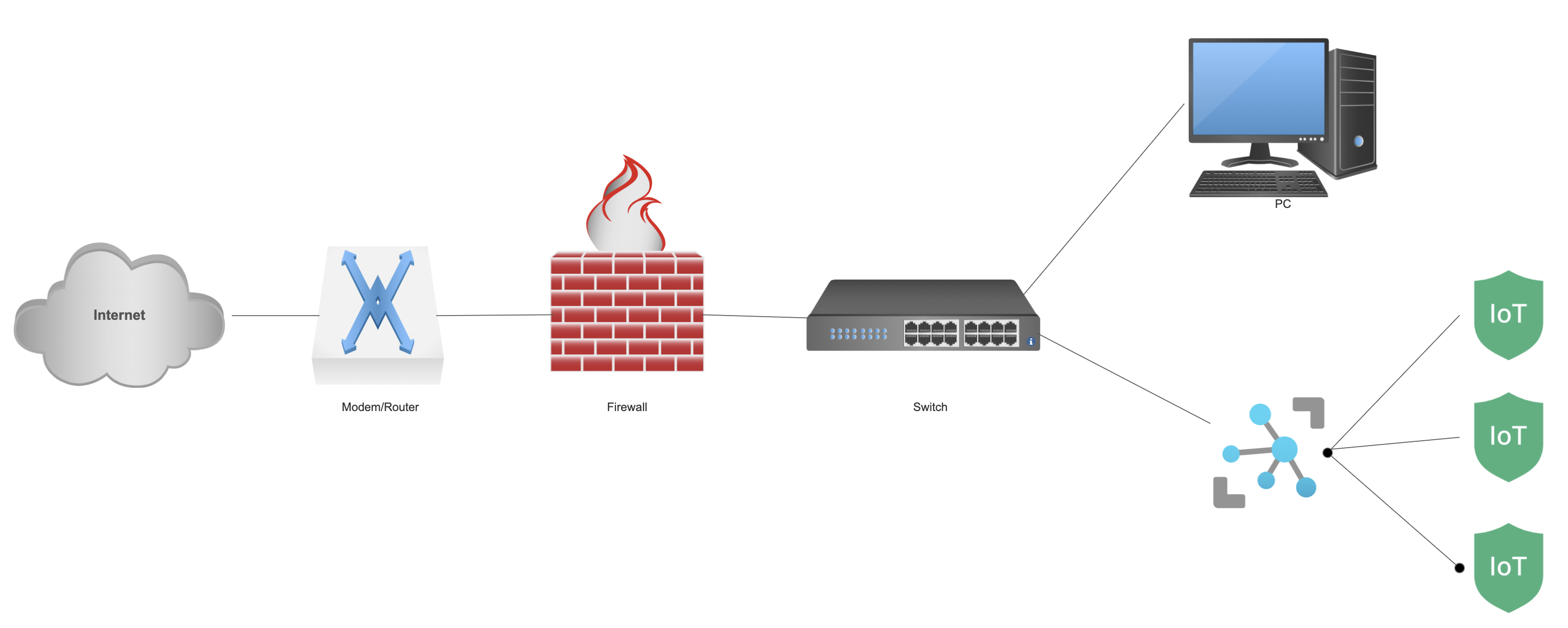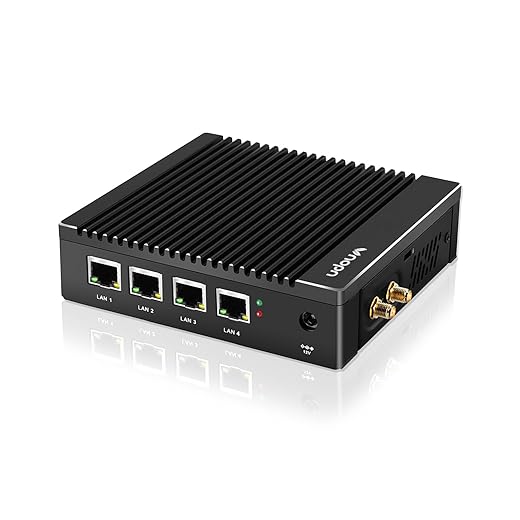In today’s digital world, our homes are full of smart devices and constant internet use. It’s more important than ever to keep your home network secure. A hardware firewall is key in defending against cyber threats. It protects your devices, personal info, and family safety.
Key Takeaways
- Choose the Right Firewall: Not all hardware firewalls are created equal. Look for one that offers robust features such as intrusion detection and prevention, VPN support, and advanced filtering options. Popular brands include Cisco, Netgear, and Fortinet.
- Proper Configuration: Once you have your hardware firewall, it’s crucial to configure it correctly. Change the default admin username and password to something strong and unique. Disable any unnecessary services and ports to minimize potential entry points for attackers.
- Regular Updates: Keep your firewall’s firmware up to date. Manufacturers frequently release updates that patch vulnerabilities and improve performance. Enable automatic updates if available, or set a reminder to check for updates regularly.
- Network segmentation is crucial for enhancing the security of your computer or network.: Use your firewall to create separate network segments for different devices. For example, you can have one segment for your work devices, another for smart home gadgets, and a guest network for visitors. This limits the spread of malware and makes it harder for attackers to access sensitive information.
- Monitor Traffic: Regularly review the logs and alerts generated by your firewall. This can help detect unusual activity that could show a security breach. Some firewalls offer real-time monitoring and alerting features that can notify you immediately of potential threats.
- Enable VPN: If your firewall supports VPN (Virtual Private Network) functionality, use it to encrypt your internet traffic. This is especially important if you work from home or frequently access sensitive information online. A VPN can protect your data from being intercepted by cybercriminals.
- Educate Your Family: Ensure everyone in your household understands the importance of network security. Teach them about safe internet practices, such as recognizing phishing attempts and avoiding suspicious downloads.
- Backup Regularly: Even with the best security measures, breaches can still happen. Regularly back up important data to an external drive or cloud service. This ensures you can recover your information in case of a ransomware attack or other data loss incident. By implementing these steps, you can significantly enhance the security of your home network. A hardware firewall is a powerful tool, but it must be part of a comprehensive security strategy that includes regular updates, proper configuration, and ongoing vigilance.
What firewalls can’t do
While a firewall is a security device essential for protecting a computer network, there are limitations to what it can achieve. Different firewalls, such as stateful inspection firewalls, proxy firewalls, and next-generation firewalls, offer various levels of protection, but they cannot address all security concerns. For instance, a firewall also cannot prevent attacks that bypass it entirely, such as phishing or social engineering attacks. Even with a gateway firewall or a circuit-level gateway firewall, internal threats from within the internal network remain a challenge.
In a small office network, using a firewall is crucial, but it cannot replace an intrusion prevention system that actively monitors and responds to threats. Similarly, firewalls for home or a home network firewall can protect a personal computer, but they cannot secure devices not connected to the company’s network. A traditional firewall or even a virtual firewall cannot detect malware already present on a device.
While you need a firewall to protect your network perimeter, it is not a standalone solution. For comprehensive security, additional measures beyond firewall capabilities are necessary. Whether you need a firewall at home or for a business, understanding the limitations of firewall technology is crucial. Even with a Windows firewall or home network firewall, users must remain vigilant and employ other security practices to ensure complete protection.
The Importance of a Hardware Firewall
The Unsung Hero of Your Home Network: Why a Hardware Firewall Matters
In an era where our homes are becoming increasingly connected, the importance of robust cybersecurity measures cannot be overstated. While many are familiar with antivirus software and password protection, there’s an often-overlooked guardian standing watch over our digital domains: the hardware firewall. This critical component of home networking security deserves a closer look, especially for those who may not be tech-savvy but want to protect their online presence.
What is a Hardware Firewall?

Before diving into its importance, let’s clarify what a hardware firewall is. Unlike software firewalls installed on individual devices, a hardware firewall is a physical device that sits between your home network and the internet. It acts as a gatekeeper, monitoring all incoming and outgoing traffic to protect your entire network from potential threats. A hardware firewall typically comes with its own operating system and handles traffic at a much higher capacity than software firewalls. This means it can manage multiple devices simultaneously, without slowing down your network performance.
By filtering data packets based on predefined security rules, a hardware firewall can block unauthorized access, prevent malware infections, and mitigate various types of cyberattacks, such as Distributed Denial of Service (DDoS) attacks.
Hardware firewalls are typically more robust than their software counterparts, offering higher security for multiple devices connected to a network. They handle large volumes of traffic and can provide advanced features such as intrusion detection and prevention, virtual private network (VPN) support, and content filtering.
One of the key advantages of a hardware firewall is its ability to provide a centralized point of control for network security. This means that all devices connected to the network benefit from the same level of protection, with no individual installations or configurations. Hardware firewalls often come with their own operating systems, which can be updated independently of the devices they protect, ensuring that the latest security patches and features are always in place.
Another significant benefit is performance. Since hardware firewalls are dedicated devices, they can process data more efficiently than software firewalls, which have to share resources with other applications on a device. This can lead to faster internet speeds and reduced latency, especially in environments with high traffic.
Hardware firewalls provide a layer of security that attackers face difficult to bypass. Because they are at the perimeter of the network, they can block malicious traffic before it reaches individual devices. This is important for businesses and organizations that handle sensitive data, as a hardware firewall can help prevent data breaches and unauthorized access.
In summary, a hardware firewall is an essential component of a comprehensive security strategy. It not only safeguards your network from external threats, but also enhances performance and simplifies management. As cyber threats continue to evolve, investing in a reliable hardware firewall can be a critical step in protecting your digital assets and maintaining the integrity of your network.
The First Line of Defense
“A hardware firewall is like having a security guard at the entrance of your digital home,” explains Emily Parker, a cybersecurity expert at TechSafe Solutions. “It scrutinizes every piece of data trying to enter or leave your network, ensuring only safe traffic gets through.”
This comprehensive protection is crucial in today’s interconnected world. With the average household now having multiple devices connected to the internet – from smartphones and laptops to smart TVs and thermostats – having a centralized security system is more important than ever.
Advanced Features for Enhanced Security
Modern hardware firewalls come equipped with sophisticated features that go beyond simple traffic filtering. They can detect and prevent various types of cyber attacks, including malware infections and attempts to steal sensitive data.
“These devices use advanced algorithms and machine learning to identify potential threats,” Parker adds. “They can recognize patterns in network traffic that might indicate malicious activity, even if it’s a new type of attack that hasn’t been seen before.”
This proactive approach to security is valuable for home users who may not have the expertise to manually configure complex security settings on each of their devices.
Smart Home Data Privacy & Security: Tips and Guides
Secure Your Network: 10 Things to Do After Setting Up a New Router
What is a Data Leak? Unraveling the Digital Danger in a Digital World
Efficiency Without Compromise
One of the key advantages of a hardware firewall is its ability to provide robust security without impacting the performance of your devices. Unlike software firewalls that run on your computer or smartphone and use up system resources, a hardware firewall operates independently.
“This means you get top-notch security without slowing down your devices,” notes Augustine Bloom, a network engineer at HomeNet Secure. “It’s especially beneficial for households with multiple devices, as you don’t need to worry about installing and updating firewall software on each one.”
The Bottom Line
While many routers come with built-in firewall features, dedicated hardware firewalls offer higher protection and more advanced features. For homes with multiple devices or those handling sensitive information, investing in a hardware firewall can provide peace of mind and a significant boost to network security.
As our dependence on connected devices continues to grow, so does the importance of protecting our digital lives. A hardware firewall might not be the most glamorous piece of technology in your home, but it could very well be the most important for keeping your family’s data safe and secure from network address translation vulnerabilities.
Protecting Your Family
- Safeguarding Personal Information:
Protecting your personal info is crucial in today’s cybercrime world. A hardware firewall stops unauthorized access to sensitive data. This is vital for families, especially with kids who might download risky content. - Control Over Network Access:
A hardware firewall lets you control who can access your network and what they can do. This is great for parents wanting to keep their kids safe online. You can block certain websites or apps, making browsing safer.
Can a Hardware Firewall Prevent Hacking Attempts?
Yes, a hardware firewall can lower the risk of hacking. But, it’s important to know its limits and how it fits into your security plan.
How Hardware Firewalls Work

Think of a firewall as your home’s digital bouncer. It stands guard between your cozy network and the wild internet, checking every bit of data that wants to come in or go out. It’s like having a super-smart security system that never sleeps!Here’s the cool part: this digital bouncer is good at spotting trouble. It can recognize nasty stuff like malware or phishing attempts and give them the boot before they even get close to your devices. It’s like having a friend who can spot a scammer from a mile away!
But wait, there’s more! You can actually teach your firewall bouncer some tricks. Want to block that annoying neighbor’s IP address? Done. Need to stop certain types of traffic? No problem. It’s like having a customizable force field around your digital home.
Now, I know what you’re thinking – “This sounds perfect!” Well, hold your horses. Sometimes, even the best bouncers can be tricked. Clever hackers are always coming up with new disguises to sneak past. And if someone inside your network accidentally invites trouble (like clicking on a phishing email), your firewall can’t do much about that. It’s like if someone inside the club sneaks in their troublemaker friend through the back door.
Here’s a pro tip: your firewall is only as good as its training. If you don’t set it up right or keep it updated, it might let the wrong crowd in. It’s like having a bouncer who doesn’t know the difference between a VIP and a party crasher!
The firewall’s effectiveness depends on how it’s set up. If it’s not configured right or not updated, it might not protect your network well.
How Does a Hardware Firewall Enhance Security for IoT Devices?
Let’s talk about how hardware firewalls boost security for IoT devices in your home network. These firewalls offer several key advantages. They make protecting smart home gadgets easy.
First off, hardware firewalls provide centralized protection. This means all devices on your network, including IoT gadgets, get the same level of security. You don’t need to set up each device separately. It’s a one-and-done solution for your entire network.
Another big plus is traffic filtering. The firewall acts as a gatekeeper, blocking malicious content before it reaches your IoT devices. This stops many potential attacks in their tracks. Your smart home stays safer.
Hardware firewalls are also great for resource efficiency. Unlike software firewalls, they don’t use up your gadgets’ processing power or memory. This is especially important for IoT devices, which often have limited resources.
Modern hardware firewalls come with advanced features for IoT security. They include intrusion detection and prevention systems to catch suspicious activity. Some can even isolate IoT devices on a separate network for extra security. Plus, they regularly update to patch vulnerabilities and combat new threats, ensuring your firewall security remains strong.
Lastly, hardware firewalls offer robust access control. You can set specific rules for your IoT devices. This limits what they can connect to and what kind of traffic they can send or receive. It helps prevent unauthorized access and can limit the damage if a device gets hacked.
A hardware firewall acts as a comprehensive security solution for your IoT devices. It provides protection, efficiency, and control in one package.
Fortify Your Network: Protectli Firewall Vault FW4B Review
What are the Main Advantages of Using a Hardware Firewall Over a Software Firewall?
For securing your home network, choosing between hardware and a software firewall can make a big difference. Both have their perks, but let’s dive into why a packet-filtering firewall might just be your best bet.
Centralized protection through a network firewall can simplify management and enhance security across multiple devices.
One of the biggest advantages of a hardware firewall is its ability to protect all the devices on your network with a single defense system. Unlike software firewalls, which need to be installed on each device, a hardware firewall offers a one-stop solution. This means you can easily secure everything from your laptop to your smart fridge, without the hassle of setting up individual protections.
Resource Efficiency
Hardware firewalls are like the unsung heroes of network security—they do their job without hogging your device’s resources. This means your devices stay fast and responsive. On the flip side, software firewalls can slow things down, especially on older gadgets. So, if you’ve got a house full of tech, a hardware firewall is a smart choice.
Advanced Security Features
Modern hardware firewalls come packed with cool features that go beyond basic protection. Think intrusion detection, VPN support for secure remote access, content filtering, and even anti-malware scanning. These features provide a level of security that most software firewalls just can’t match.
Continuous Protection
A hardware firewall is like a vigilant guard that never sleeps. It protects your network 24/7, even when you turn off your devices. This constant protection ensures that your network is always safe from threats.
Simplified Management
Managing your network’s security can be a breeze with a hardware firewall. You can update security rules and monitor activity all from one place, which is perfect if you’re not a tech wizard. It simplifies the process, making it accessible for everyone.
Pros and Cons:
Hardware Firewalls:
- Centralized protection for all devices
- Doesn’t slow down devices
- Advanced security features
- Continuous, always-on protection
- Easy to manage
- Can be more expensive upfront
- Requires some initial setup, particularly when configuring your proxy firewall for optimal performance.
Software Firewalls:
- Often cheaper or free
- Easy to install on individual devices
- Good for basic protection
- Can slow down devices
- Requires installation on each device to ensure comprehensive coverage by your security software.
- May lack advanced features
While both hardware and software firewalls have their place, a hardware firewall offers a more robust, efficient, and user-friendly solution for home network security. Whether you’re protecting a few devices or a whole smart home, the peace of mind a network firewall provides is well worth the investment.
Can Hardware Firewalls be Integrated with Other Security Measures for Enhanced Protection?
Yes, hardware firewalls can work with other security tools for better protection. This approach, called “defense in depth,” boosts your security. Here’s how hardware firewalls and other tools work together:
Intrusion Detection and Prevention Systems (IDS/IPS)
Many hardware firewalls have IDS/IPS. These systems watch for suspicious traffic and block threats. They add an extra layer of security, catching attacks the firewall might miss.
Virtual Private Networks (VPNs)
Hardware firewalls can support VPNs for secure remote access. They encrypt data and ensure only allowed users can get in. The firewall can also enforce VPN policies. Hardware firewalls can manage multiple VPN connections simultaneously, allowing businesses to accommodate many remote users without compromising security. They often come equipped with advanced features, such as intrusion detection and prevention systems (IDPS), which monitor traffic for suspicious activity and can block potential threats in real-time.
Hardware firewalls typically offer centralized management capabilities, enabling IT administrators to configure and monitor VPN settings across the network from a single interface. This streamlines updating security protocols and managing user access, ensuring the organization remains compliant with industry regulations and best practices.
In terms of performance, hardware firewalls are more robust than software-based solutions, as they are dedicated devices designed specifically for handling network traffic. This can lead to improved throughput and reduced latency, which is important for applications that require real-time data transmission, such as video conferencing or VoIP.
Many modern hardware firewalls support advanced VPN protocols, such as OpenVPN, IPSec, and SSL/TLS, providing flexibility in how remote access is implemented. This allows organizations to choose the most suitable protocol based on their specific security requirements and network architecture.
Integrating a hardware firewall with VPN capabilities not only enhances security for remote access but also contributes to a more resilient and efficient network infrastructure, safeguarding sensitive data while enabling seamless connectivity for users.
TP-Link Professional Wired Gigabit VPN Router
Antivirus and Anti-malware Solutions
Firewalls and antivirus software work together to protect against distinct threats. Some firewalls even have antivirus built-in, scanning for malware.
Content Filtering
Hardware firewalls can block harmful websites or limit certain content. This is useful for families wanting to keep their online environment safe for kids.
Network Segmentation
Firewalls can create separate network segments or VLANs. This isolates devices like IoT gadgets from sensitive areas of your network. If one segment gets attacked, the others stay safe.
Security Information and Event Management (SIEM)
For advanced setups, firewalls can work with SIEM systems. SIEM tools collect and analyze log data from security devices, giving a complete view of your network’s security.
Regular Updates and Patch Management
Keeping your firewall updated is key to its effectiveness. Many firewalls can update automatically, protecting against new threats.
Creating a Safe Home for Kids: Childproofing Your Home with Smart Tech
Can a Hardware Firewall be Integrated with a VPN for Added Security?
Yes, combining a hardware firewall with a VPN adds layers of protection to your home network. This setup offers many benefits, including improved firewall security and easier management of network address translation.
Enhanced Encryption
When you add a VPN to a hardware firewall, it ensures all your traffic is encrypted. This makes it hard for hackers to see your data as it moves.
Secure Remote Access
Hardware firewalls support VPNs, allowing you to safely connect to your network from anywhere. This is great for keeping your network safe when you’re not at home.
Traffic Filtering
With a hardware firewall, you can limit VPN traffic to certain ports. This helps block potential attacks. It also checks VPN traffic for suspicious activity, adding more security.
Network Segmentation
Advanced firewalls can create separate networks for VPN traffic. This keeps risky connections away from your main network, adding more security.
Centralized Management
Managing your VPN and firewall together from one place makes things easier. It helps keep your network secure consistently.
Improved Performance
Hardware firewalls handle traffic well, even with VPN encryption. They can manage the extra work without slowing down your network.
Can a Firewall be Bypassed by Skilled Hackers?

Yes, skilled hackers can get past firewalls. They use different methods based on the firewall and network vulnerabilities. But realize, while they CAN bypass a firewall, a firewall is only as strong as its weakest link. This means, if you aren’t keeping up with standard protocols and regular maintenance, you might as well open the door to let them in. That can be prevented simply by staying on top of updates. Here’s how they do it:
Techniques Used to Bypass Firewalls
- Exploiting Misconfigurations
Firewalls work only as well as their setup. If they’re not set up right, they might leave open ports or let in the wrong kind of traffic. This can be a way for hackers to get into the network without permission. - Social Engineering
Hackers often trick people into giving away info or doing things that hurt security. They might send fake emails that look real, tricking people into clicking on bad links. This can get around firewall protections. - Hiding Malicious Payloads
Attackers can hide their bad stuff in files or websites that seem safe. For example, they might put malware in a picture or use trusted sites to send harmful stuff. This way, firewalls that block known threats won’t catch it. - Utilizing Backdoors
Firewalls might have secret ways in which hackers can find. These secret doors let attackers escape security without being caught. It’s important to keep firewalls updated and checked for these backdoors. - Physical Access
If a hacker physically gets into the network, they can easily get past firewalls. They might plug a device into the network or find another way to get around security.
Is it Possible to Detect Firewall Bypassing?
Yes, finding out if someone has bypassed a firewall is possible. But how well you can find it depends on the attack and security you have. Here are some ways to detect it:
Detection Methods
- Advanced Security Tools:
Organizations can employ advanced security measures, such as Endpoint Detection and Response (EDR) tools and intrusion detection systems (IDS). These tools actively monitor network traffic and endpoint activities for suspicious behavior, allowing the detection of malware that may have bypassed the firewall. For instance, if a malicious payload is hidden within a legitimate file, EDR tools can identify unusual patterns or behaviors that indicate a breach. - Anomaly Detection:
By establishing a baseline of normal network behavior, security systems can detect anomalies that may suggest firewall bypassing. For example, if there is a sudden spike in outbound traffic or unusual access to sensitive data, it could show that an attacker successfully bypassed the firewall and is attempting to infiltrate data. - Log Analysis:
Regularly reviewing firewall logs can help identify unauthorized access attempts or unusual traffic patterns. If a firewall is configured to log all traffic, network administrators can analyze these logs to spot suspicious activities that may show an attempt to bypass security measures.
Limitations of Detection
Even though there are ways to detect firewall bypassing, there are challenges:
- Evasion Techniques
Skilled hackers use tricks to avoid being caught. They might encrypt their traffic or use sneaky methods to not trigger alerts. This makes it hard for security to find the bad stuff. - Misconfigurations
If a firewall isn’t set up right, it might not log or alert on certain traffic. This lets attackers work without being noticed. It’s important to regularly check and update firewalls to keep them working well.
Is Continuous Monitoring Necessary to Detect Bypassing?
Yes, continuous monitoring is essential for effectively detecting firewall bypassing. You don’t have to be on top of it 24/7, but you need to be aware and on the lookout for any firmware updates that would impact its effectiveness. Typically, these kinds of updates are automatic, but it’s important to remain vigilant.
Here’s why it plays a crucial role in maintaining network security:
Proactive Threat Detection
- Real-Time Monitoring
Continuous monitoring allows organizations to observe network traffic in real-time. This capability is vital for identifying suspicious activities that may indicate an attempt to bypass firewall protections. By capturing data such as source and destination IP addresses, ports, and protocols, security teams can quickly spot anomalies that could signify a breach or an evasion attempt. - Vulnerability Identification
Regular monitoring helps uncover potential weaknesses in firewall configurations or performance. By continuously assessing the effectiveness of the firewall, organizations can identify and rectify vulnerabilities before attackers can exploit them. This proactive approach is crucial in a landscape where cyber threats are constantly evolving.
Response to Evolving Threats
- Adaptability
Cybercriminals frequently change their tactics to bypass security measures. Continuous monitoring enables organizations to adapt their defenses to new threats. For instance, if a particular method of bypassing is detected, security teams can adjust firewall rules or implement additional security measures to counteract that specific threat. - Audit and Compliance
Continuous monitoring is not just about detecting threats, but also involves ensuring compliance with security policies and regulations. Regular audits of firewall logs and configurations can help maintain alignment with organizational security standards, ensuring that any unauthorized changes or vulnerabilities are promptly addressed.
Can Firewall Rules Prevent Bypassing Attempts?
Yes, properly configured firewall rules can significantly help prevent bypassing attempts, although they are not foolproof. Here’s how firewall rules contribute to preventing bypassing:
Traffic Filtering
Firewall rules define what types of traffic are allowed or blocked. By setting strict rules, you can filter out potentially malicious traffic before it enters your network. For example, you can block traffic from known malicious IP addresses or restrict access to certain ports commonly exploited by attackers.
Access Control
Firewall rules can be used to control who has access to your network and what resources they can reach. By implementing the principle of least privilege, you can ensure that users and devices only have access to the resources they need, reducing the potential attack surface.
Application-Level Filtering
Advanced firewalls can implement rules based on application-level data to enhance firewall security. This allows for more granular control, such as blocking specific types of file transfers or restricting access to certain web applications.
Stateful Inspection
Many modern firewalls use stateful inspection, which keeps track of the state of network connections. This allows the firewall to make more informed decisions about whether to allow or block traffic based on the context of the connection.
Logging and Alerting
Firewall rules can be set to log suspicious activities and generate alerts. While this doesn’t directly prevent bypassing attempts, it allows quick detection and response to potential threats.
Limitations of Firewall Rules
While firewall rules are crucial for security, they have limitations:
- Zero-Day Exploits: Firewall rules may not protect against new, unknown threats.
- Insider Threats: Rules typically focus on external threats and may not prevent attacks within the network.
- Complexity: As networks grow more complex, managing firewall rules becomes more challenging, potentially leading to misconfigurations.
- Encrypted Traffic: Some firewalls may have difficulty inspecting encrypted traffic, attackers.
Best practices for configuring a hardware firewall
Here are some best practices for configuring a hardware firewall to maximize security for your home network:
- Change default passwords and usernames
Don’t keep the default admin credentials that come with the firewall. Create strong, unique passwords. - Keep firmware updated to maintain the effectiveness of your network firewall.
Regularly check for and install firmware updates from the manufacturer to patch vulnerabilities. - Enable logging
Turn on logging features to track traffic and potential threats. Review logs periodically. - Use the principle of least privilege to ensure that your security software only grants access to necessary resources.
Only open ports and allow traffic that is absolutely necessary. Block everything else by default. - Implement egress filtering
Control outbound traffic in addition to inbound to prevent malware from communicating out. - Enable intrusion prevention features
Turn on IPS capabilities to detect and block known attack patterns. - Segment your network
Use VLANs or multiple interfaces to separate devices and limit lateral movement. - Configure remote access securely
If enabling remote management, use strong authentication and encryption. - Disable unnecessary services
Turn off any services or protocols you don’t actively use. - Use application-layer filtering
Enable deep packet inspection to filter traffic based on applications, not just ports. - Test your configuration
Regularly scan your network and test the firewall to ensure rules are working as intended. - Document your setup
Keep detailed records of your firewall configuration for troubleshooting and auditing.
The key is to take a “default deny” approach and only allow the minimum required for your network to function. Regularly review and update your rules as needs change. While no configuration is perfect, following these best practices will significantly improve your network security.
Final Thoughts
Firewall rules are a critical component in preventing bypassing attempts, but they should be part of a comprehensive security strategy. Regular updates, continuous monitoring, and a defense-in-depth approach are necessary to maintain strong network security. While no single measure can guarantee complete protection, well-configured firewall rules significantly raise the bar for potential attackers and form a crucial line of defense for your network firewall.
Features
| Processor | 1.6 GHz celeron |
| RAM | 8 GB DDR3L |
| Hard Drive | 120 GB SSD |
| Chipset Brand | Intel |
| Card Description | Dedicated |
| Brand | Protectli |
| Series | FW4B – 4 Port |
| Item model number | FW4B-0-8-120 |
| Hardware Platform | PC |
| Operating System | Windows |
| Item Weight | 3.52 pounds |
| Product Dimensions | 4.5 x 4.3 x 1.5 inches |
| Item Dimensions LxWxH | 4.5 x 4.3 x 1.5 inches |
| Color | Black |
| Processor Brand | Intel |
| Number of Processors | 1 |
| Computer Memory Type | DDR3 SDRAM |
| Flash Memory Size | 120 |
| Hard Drive Interface | Solid State |
| Batteries | 1 CR2 batteries required. |
- THE VAULT (FW4B): Secure your network with a compact, fanless & silent firewall. Comes with US-based Support & 30-day money back guarantee!
- CPU: Intel Quad Core Celeron J3160, 64 bit, up to 2.2GHz, AES-NI hardware support
- PORTS: 4x Intel Gigabit Ethernet ports, 2x USB 3.0, 1x RJ-45 COM, 2x HDMI
- COMPONENTS: 8GB DDR3L RAM, 120GB mSATA SSD. coreboot BIOS optional, must be installed by user.
- COMPATIBILITY: No OS pre-installed. All hardware tested with pfSense, untangle, OPNsense and other popular open-source software solutions.

















